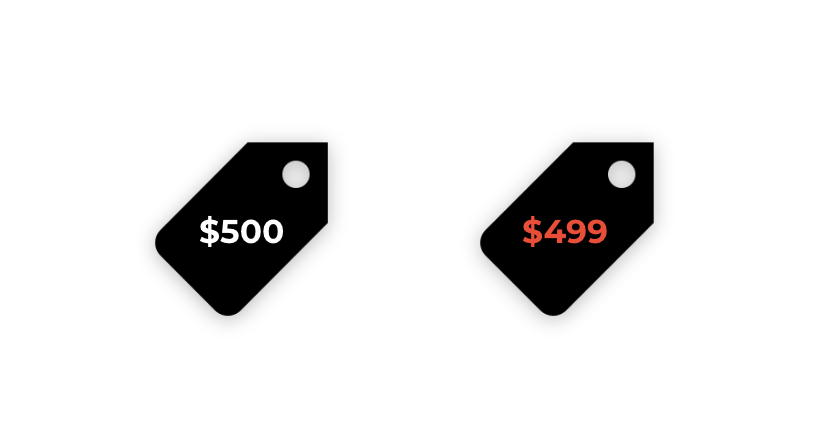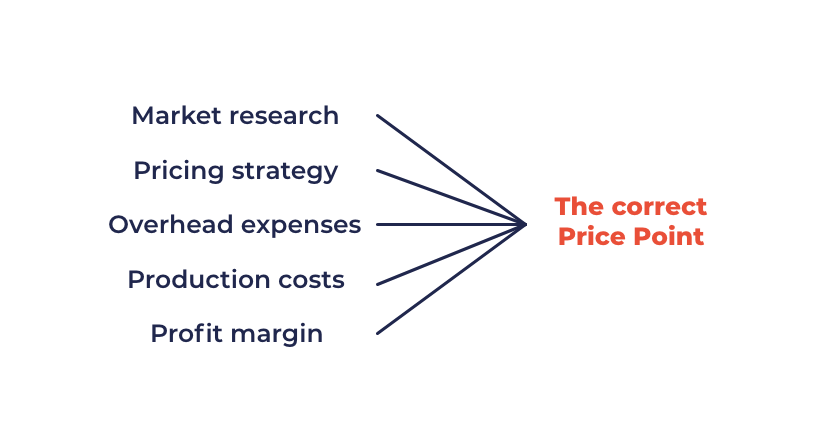The role of price points in E-commerce success
The right price Point is found on multiple factors. This blog post will guide you through how to find the right Price Point and maximize your profits.

The "price point" refers to the retail price at which a product can maintain a consistently strong demand. In simpler terms, it's the point at which you maximize your profits. It's essential not to undercut your potential earnings by sacrificing quality or reducing quantities when customers are willing to pay more. However, you also want to avoid setting the price so high that it drastically reduces demand and sends your sales plummeting. Price points are typically used in marketing and pricing strategies to target specific customer segments and to convey a particular perceived value for the product or service.
This blog will dive into why price points are essential for your E-commerce business and how you find the right pricing point for your product.
What are price points?
Price points are often chosen strategically based on various factors, including market demand, competition, production costs, and the desired profit margin. For example, could you price a new smartphone at $499 rather than $500 to make it seem more affordable to potential customers, even though the actual price difference is small, this strategy is also called psychological pricing.
Different price points can cater to different customer segments or offer variations in features and quality. For instance, a clothing brand might have different price points for its products, with lower-priced items targeting budget-conscious customers and higher-priced items targeting those willing to pay more for premium quality or design.
In summary, a price point is a specific price at which a product or service is sold, and it plays a crucial role in pricing strategies and marketing decisions. The prices are strategically chosen to achieve various goals, such as maximizing revenue, appealing to specific customer segments, or creating a perceived value for the product or service.

How to set a price point
Several things must be considered and researched before setting the right price point. First, you'll need to do market research to help you understand your target audience and find competitors' prices and overall market conditions. This research helps identify your customers' preferences, price sensitivity, and competitors' pricing strategies.
You must consider the production costs, overhead expenses, and desired profit margins to set the right price point. This can be done by conducting a cost analysis. The chosen price should cover these costs while still allowing for a profit. When these two pieces of research have been made, can you start looking into your pricing strategy.
Pricing strategy
Price points are integral to a company's pricing strategy. In fact, are price points a fundamental element of your pricing strategy. They are set based on various factors, including costs, market research, competition, and customer segmentation. Different pricing strategies can be employed, such as:
Penetration pricing: You are setting a low initial price to gain market share quickly or enter a new market.
Skimming pricing: When you are starting with a high price and gradually lowering it over time to target early adopters and price-insensitive customers.
Premium pricing: When pricing a product higher to convey a sense of quality or exclusivity.
Psychological pricing: When using prices that end in .99 or .95 to make your product seem more affordable.
Bundle pricing: When you are offering multiple products or services together at a discounted price.
Segmenting customers: Setting different price points for customer segments based on demographics, geographic location, or purchasing behavior allows you to target various customer groups effectively.
Competitive pricing: Analyzing your competitors' pricing strategies can help determine how to position your price points. It can involve pricing above, below, or at a similar level to your competitors.
Testing and adjusting: Price points are not fixed forever. You can test different price points through techniques like A/B testing to see how your customers respond. You may then adjust prices based on the results to find the right price point for your products.
Perceived value: Price points are closely tied to the perceived value of a product or service. By setting the right price, you can influence how your customers perceive the quality and worth of what they buy.
Promotions and discounts: Price points can be used with promotions and discounts to create a sense of urgency and drive sales. For example, offering a limited-time discount can encourage your customers to purchase.
At PriceShape, we understand that implementing any pricing strategy effectively can be challenging. That’s why our pricing tool is designed to automate and optimize your strategy for your specific needs. With our platform, you can easily monitor competitor prices, analyze market trends, and adjust your pricing dynamically to stay ahead in the market and maximize your profits effortlessly.

Setting the right price points for cross-border E-commerce
Expanding into international markets means navigating diverse regional demands, fluctuating currencies, and varying purchasing power. Setting the right price points in cross-border e-commerce is crucial to remain competitive and appeal to local consumers while safeguarding your profit margins.
At PriceShape, we simplify this process with our cross-border data solutions. Our platform provides you with the tools to:
- Monitor regional pricing trends and competitor strategies in real-time.
- Understand local market conditions and adjust your price points accordingly.
- Gain visibility into your distribution network to identify resellers and ensure consistent pricing.
So what have we learned?
Setting the price point is essential for your business. This will help you in various ways, among others, to find the perceived value and, thereby, what pricing strategy is most suitable for your business. Moreover, did we learn that when establishing the highest price possible, several things must be taken into consideration:
- The amount that your consumers are willing to pay for the product
- The position of your company
- How much does your competitor charge
- The volumes that you can supply
- How eagerly sought your product as compared to competitors
Stay one step ahead of your competitors.
The modern business world is all about constantly improving yourself. Today, it's hard to stay in control because so many things are happening all at once, and it's tricky to figure out what's most important. Priceshape can help you keep track of changes and adjust your pricing strategies quickly. Moreover, using a tool like PriceShape allows you to use dynamic pricing and stay one step ahead of your competitors.
Now, it's your turn to decide the right product prices. Experiment responsibly, learn from your experiences, and stay in tune with what's happening with you and your customers.
Even though there's no one-size-fits-all solution for all your problems, there's always a personal best you can aim for. If you are interested in how PriceShape can help you, click here to learn why you should use PriceShape.

.png?width=458&name=1200-628%20%E2%80%93%2060%20(1).png)